My Space Engine Adventures, also any space related topic or news. www.spaceengine.org to download space engine. The game is free by the way. Please feel free to ask me anything, provide suggestions on systems to visit or post any space related topic.Check out my other blog https://bunsandsharks.tumblr.com for rabbit and shark blog.
294 posts
Latest Posts by sharkspaceengine - Page 9
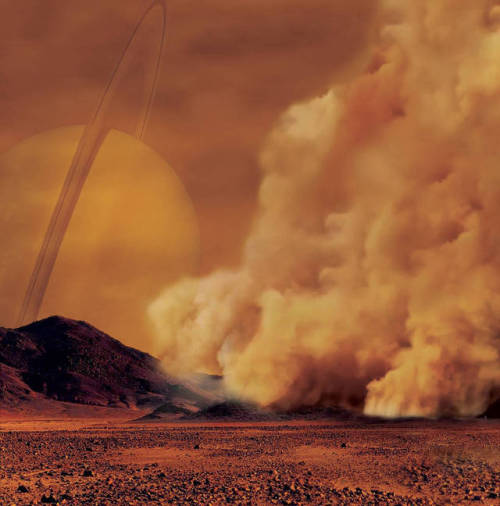
Dust Storms on Titan Spotted for the First Time
Data from NASA’s Cassini spacecraft has revealed what appear to be giant dust storms in equatorial regions of Saturn’s moon Titan. The discovery, described in a paper published on Sept. 24 in Nature Geoscience, makes Titan the third Solar System body, in addition to Earth and Mars, where dust storms have been observed.
The observation is helping scientists to better understand the fascinating and dynamic environment of Saturn’s largest moon.
“Titan is a very active moon,” said Sebastien Rodriguez, an astronomer at the Université Paris Diderot, France, and the paper’s lead author. “We already know that about its geology and exotic hydrocarbon cycle. Now we can add another analogy with Earth and Mars: the active dust cycle, in which organic dust can be raised from large dune fields around Titan’s equator.”

Titan is an intriguing world – in ways quite similar to Earth. In fact, it is the only moon in the Solar System with a substantial atmosphere and the only celestial body other than our planet where stable bodies of surface liquid are known to still exist.
There is one big difference, though: On Earth such rivers, lakes and seas are filled with water, while on Titan it is primarily methane and ethane that flows through these liquid reservoirs. In this unique cycle, the hydrocarbon molecules evaporate, condense into clouds and rain back onto the ground.

The weather on Titan varies from season to season as well, just as it does on Earth. In particular, around the equinox – the time when the Sun crosses Titan’s equator – massive clouds can form in tropical regions and cause powerful methane storms. Cassini observed such storms during several of its Titan flybys.

When Rodriguez and his team first spotted three unusual equatorial brightenings in infrared images taken by Cassini around the moon’s 2009 northern equinox, they thought they might be the same kind of methane clouds; however, an investigation revealed they were something completely different.
“From what we know about cloud formation on Titan, we can say that such methane clouds in this area and in this time of the year are not physically possible,” said Rodriguez. “The convective methane clouds that can develop in this area and during this period of time would contain huge droplets and must be at a very high altitude – much higher than the 6 miles (10 kilometers) that modeling tells us the new features are located.”
The researchers were also able to rule out that the features were actually on the surface of Titan in the form of frozen methane rain or icy lavas. Such surface spots would have a different chemical signature and would remain visible for much longer than the bright features in this study, which were visible for only 11 hours to five weeks.
In addition, modeling showed that the features must be atmospheric but still close to the surface – most likely forming a very thin layer of tiny solid organic particles. Since they were located right over the dune fields around Titan’s equator, the only remaining explanation was that the spots were actually clouds of dust raised from the dunes.

Organic dust is formed when organic molecules, formed from the interaction of sunlight with methane, grow large enough to fall to the surface. Rodriguez said that while this is the first-ever observation of a dust storm on Titan, the finding is not surprising.
“We believe that the Huygens Probe, which landed on the surface of Titan in January 2005, raised a small amount of organic dust upon arrival due to its powerful aerodynamic wake,” said Rodriguez. “But what we spotted here with Cassini is at a much larger scale. The near-surface wind speeds required to raise such an amount of dust as we see in these dust storms would have to be very strong – about five times as strong as the average wind speeds estimated by the Huygens measurements near the surface and with climate models.”

The existence of such strong winds generating massive dust storms implies that the underlying sand can be set in motion, too, and that the giant dunes covering Titan’s equatorial regions are still active and continually changing.
The winds could be transporting the dust raised from the dunes across large distances, contributing to the global cycle of organic dust on Titan and causing similar effects to those that can be observed on Earth and Mars. source






O’Sirus System - Post 4 (Rings)
Two planets in the O’Sirus System have rings, the 7th and 10th planets respectively.
The 7th planet is an ice-world with a thick icy crust floating on a sub-surface ocean. It is roughly 0.30 Earth-masses, has a radius 75% that of Earth and orbits 1.32 AU from the sun. The surface has a carbon dioxide atmosphere of approximately the same pressure as the atmosphere of Mars and surface temperatures of 133 K or -224 °F.
The 10th world is small ice giant 10.5 times more massive than Earth, has a radius 2.8 times larger than Earth and orbits at a distance of 6.02 AU. This world also has a pronounced ring system.
High Resolution Pics
Picture 1 - The 7th Planet
Picture 2 - Ring Closeup
Picture 3 - Another Closeup
Picture 4 - The 10th Planet
Picture 5 - Closeup
Picture 6- Ring Transit
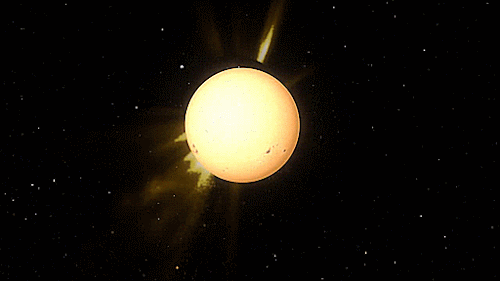


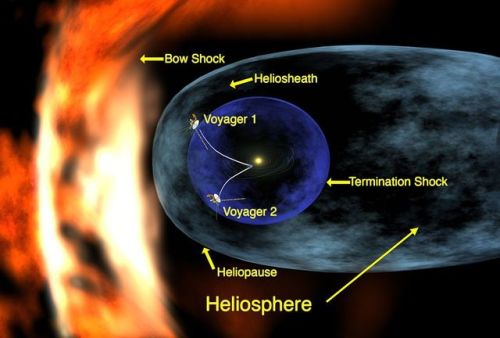
The heliosphere is the bubble-like region of space dominated by the Sun, which extends far beyond the orbit of Pluto. Plasma “blown” out from the Sun, known as the solar wind, creates and maintains this bubble against the outside pressure of the interstellar medium, the hydrogen and helium gas that permeates the Milky Way Galaxy. The solar wind flows outward from the Sun until encountering the termination shock, where motion slows abruptly. The Voyager spacecraft have explored the outer reaches of the heliosphere, passing through the shock and entering the heliosheath, a transitional region which is in turn bounded by the outermost edge of the heliosphere, called the heliopause. The shape of the heliosphere is controlled by the interstellar medium through which it is traveling, as well as the Sun and is not perfectly spherical. The limited data available and unexplored nature of these structures have resulted in many theories. The word “heliosphere” is said to have been coined by Alexander J. Dessler, who is credited with first use of the word in the scientific literature.
On September 12, 2013, NASA announced that Voyager 1 left the heliopause on August 25, 2012, when it measured a sudden increase in plasma density of about forty times. Because the heliopause marks one boundary between the Sun’s solar wind and the rest of the galaxy, a spacecraft such as Voyager 1 which has departed the heliosphere, can be said to have reached interstellar space. source

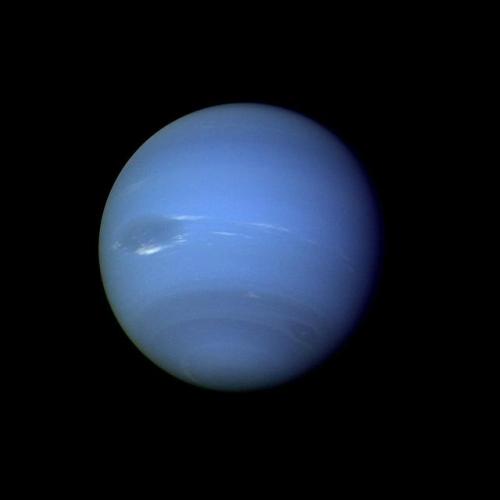
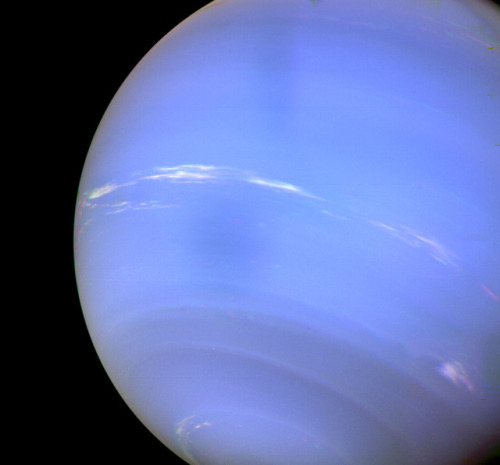
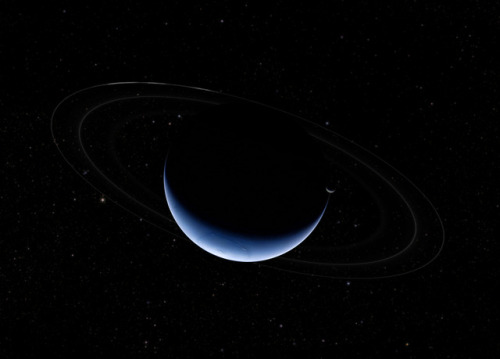
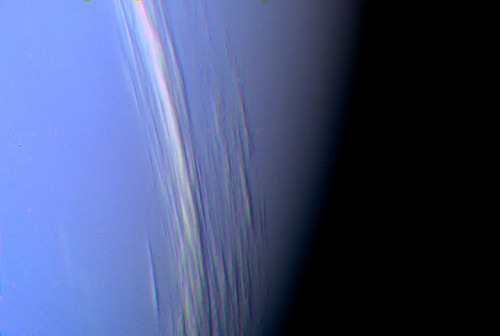
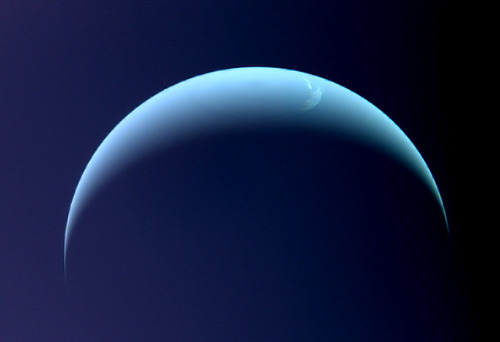
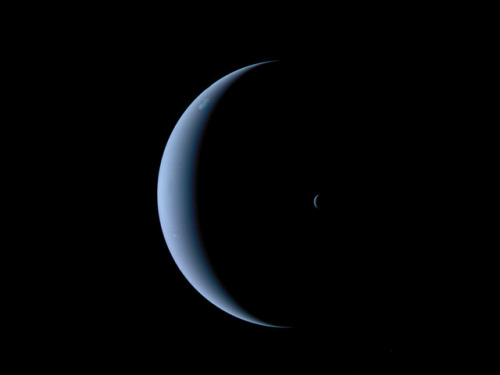
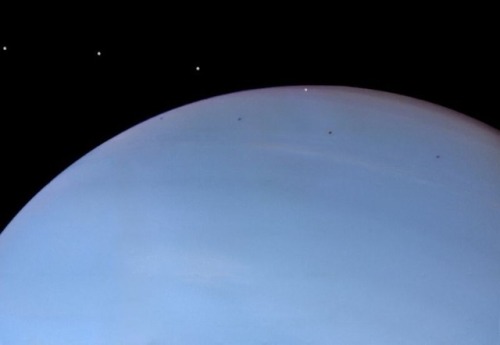
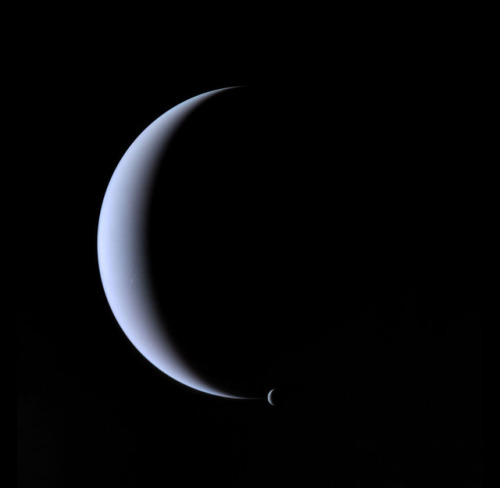
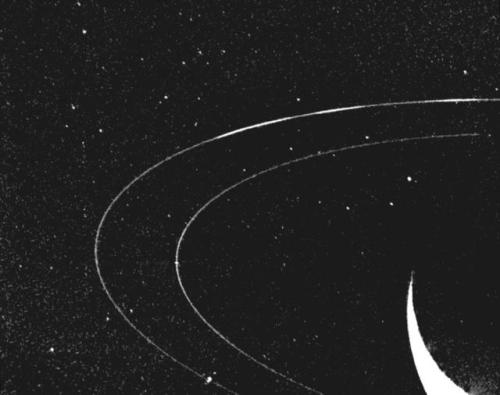
Neptune ♆
On this day in 1846 was discovered the planet Neptune.
The ice giant Neptune was the first planet located through mathematical predictions rather than through regular observations of the sky. (Galileo had recorded it as a fixed star during observations with his small telescope in 1612 and 1613.) When Uranus didn’t travel exactly as astronomers expected it to, a French mathematician, Urbain Joseph Le Verrier, proposed the position and mass of another as yet unknown planet that could cause the observed changes to Uranus’ orbit. After being ignored by French astronomers, Le Verrier sent his predictions to Johann Gottfried Galle at the Berlin Observatory, who found Neptune on his first night of searching in 1846. Seventeen days later, its largest moon, Triton, was also discovered.
Neptune is invisible to the naked eye because of its extreme distance from Earth. Interestingly, the highly eccentric orbit of the dwarf planet Pluto brings Pluto inside Neptune’s orbit for a 20-year period out of every 248 Earth years. Pluto can never crash into Neptune, though, because for every three laps Neptune takes around the Sun, Pluto makes two. This repeating pattern prevents close approaches of the two bodies.
Nearly 4.5 billion kilometers (2.8 billion miles) from the Sun, Neptune orbits the Sun once every 165 years.
Uranus’ blue-green color is also the result of atmospheric methane, but Neptune is a more vivid, brighter blue, so there must be an unknown component that causes the more intense color.
Despite its great distance and low energy input from the Sun, Neptune’s winds can be three times stronger than Jupiter’s and nine times stronger than Earth’s.
Winds on Neptune travel faster than the speed of sound.
In 1989, Voyager 2 tracked a large, oval-shaped, dark storm in Neptune’s southern hemisphere. This “Great Dark Spot” was large enough to contain the entire Earth.
Neptune has five known rings. Voyager 2’s observations confirmed that these unusual rings are not uniform but have four thick regions (clumps of dust) called arcs. The rings are thought to be relatively young and short-lived.
Neptune has 14 known moons, six of which were discovered by Voyager 2.
Triton, Neptune’s largest moon, orbits the planet in the opposite direction compared with the rest of the moons, suggesting that it may have been captured by Neptune in the distant past.
To know more about the planet Neptune click here and here.
Images credit: NASA/JPL- Caltech (some images processed by Kevin M. Gill)
Ten interesting facts about Saturn
Saturn is sometimes called “The Jewel of the Solar System.” It is a planet that is nothing like our own. Humans have been gazing up at Saturn for a long time. They have been wondering about it for thousands of years.
Here are some fun facts about the Ringed Planet.

Saturn is huge. It is the second largest planet in our Solar System. Jupiter is the only planet that is bigger.

The rings are huge but thin. The main rings could almost go from Earth to the moon. Yet, they are less than a kilometer thick.

Four spacecraft have visited Saturn: Pioneer 11, Voyager 1 and 2, and the Cassini-Huygens mission have all studied the planet.

Saturn has oval-shaped storms similar to Jupiter’s: The region around its north pole has a hexagonal-shaped pattern of clouds. Scientists think this may be a wave pattern in the upper clouds. The planet also has a vortex over its south pole that resembles a hurricane-like storm.

Saturn is made mostly of hydrogen and helium: It exists in layers that get denser farther into the planet. Eventually, deep inside, the hydrogen becomes metallic. At the core lies a hot interior. (click the image for a better resolution).

Saturn has 62 moons: Some of these are large, like Titan, the second largest moon in the Solar System. But most are tiny – just a few km across, and they have no official names. In fact, the last few were discovered by NASA’s Cassini orbiter just a few years ago. More will probably be discovered in the coming years.

Saturn orbits the Sun once every 29.4 Earth years: Its slow movement against the backdrop of stars earned it the nickname of “Lubadsagush” from the ancient Assyrians. The name means “oldest of the old”.

In Saturn there is aurora: Photographic composition made by the Hubble Space Telescope showing the occurrence of aurora in the southern hemisphere of Saturn at intervals of two days.The aurora is visible only in the ultraviolet.

Saturn spins on its axis very fast. A day on Saturn is 10 hours and 14 minutes.

You can see Saturn with your own eyes: Saturn appears as one of the 5 planets visible with the unaided eye. If Saturn is in the sky at night, you can head outside and see it. To see the rings and the ball of the planet itself, you’ll want to peer through a telescope. But you can amaze your friends and family by pointing out that bright star in the sky, and let them know they’re looking at Saturn.
sources: nasa.gov, universetoday.com and solarsystem.nasa.gov
Thank You for Following
I see I now have 13 followers. Thank you for that. Glad to see other people are enjoying my space engine pics and other astronomy topics.
Once again thank you.







O’Srius System - Post 3 (Stunning World)
Here we come across the smaller component of a double planetary system, being the 9 and 10th planets from the star. This planet is by far the most visually stunning world I have come across in the 6 months of playing space engine.
The world is roughly the same size as Earth, but only 0.58 times the mass. The surface is covered in liquid nitrogen oceans and nitrogen ice-caps. The planet has a surface temperature of 68 K or -337 °F. The atmosphere is composed of nitrogen and argon with a surface pressure of 0.095 atmospheres. The surface has a nitrogen cycle, much the same as Earth has a water cycle.
High Resolution Pics
Picture 1 - Crescent
Picture 2 - Gibbous
Picture 3 -
Picture 4 - River Channels
Picture 5 - Varied terrain
Picture 6 - Polar Cap
Picture 7 - Nitrogen Shoreline

Behold Tharsis Montes, three massive shield volcanoes in the Tharsis region of Mars. In this illustration by Dutch artist Kees Veenenbos, using data from NASA’s Mars Orbiter Laser Altimeter, we can see the volcanoes Arsia Mons, Pavonis Mons and Ascraeus Mons, southwest to northeast.
(Space 4 Case)







O’Sirus System - Post 2 (Weird Life)
The System’s 6th planet, and first world I’ve come across in my journey that has life on the surface. This is one odd life-supporting world. It is a small world, roughly the size of Mars, but only half of Mars’ mass, with a low average density. The atmosphere is 99.8% carbon dioxide and 0.2% oxygen, with a thickness only 4% that of Earth’s atmosphere. The surface has an average temperature of 181 K or -133 °F. And it has one large moon in orbit.
Unfortunately Space Engine only shows life as coloring on the planet’s surface; therefore, I have no idea what form or appearance it has. Based off of the temperatures and atmospheric composition, this the life likely has has a low metabolic rate that uses a liquid other than just water to metabolize, possibly an Eutectic Water-Ammonia solution. Carbon-based if feasible, but involves significantly different chemistry than we are familiar with. The purple coloring likely an adaptation to utilize the low sunlight levels and probably uses primarily red or near infrared light for photosynthesis.
High Resolution Pics
Picture 1 - Planet and Moon
Picture 2 -
Picture 3 - The Equator
Picture 4 - Northern Ice Cap
Picture 5 - Planet, Moon, Sun, Inner Planets and Andromeda
Picture 6 - The Surface
Picture 7 - Moon and Nebula Rising





O’Sirus System - Post 1 (Hellish Moon)
We have gone deeper in the Triangulum Galaxy. We are now only 1,473 light years from the NGC 604 Nebula. Our next system is the O’Sirus System, a dim Orange Dwarf orbited by 12 planets, including 1 world that supports life.
The lone satellite orbiting the third planet. Roughly a third of Earth’s mass with a super-heated water vapor atmosphere. Atmospheric temperatures reach up to 1,000 K (1,340 °F), and glowing clouds of Titanium Dioxide hoover over the moon. The sun is only a K9V type star, but at only 0.11 AU, it covers an area of the sky 7.5 times larger than a Full Moon on Earth.
Space Engine System ID: RS 1229-171-8-11850488-229
High Resolution Pics
Picture 1 - Volcanic moon with glowing metallic clouds.
Picture 2 - Atmospheric Haze
Picture 3 - The Surface
Picture 4 - Lunar Sky
Picture 5 - Eclipse






Vernier System - Post 4 (Alien Skies)
While exploring the Vernier System, I took a few shots at the skies of some of the planet’s and the moons.
High Resolution Pics
Picture 1 - Second Moon orbiting the 4th planet
Picture 2 - Sunset on the second planet
Picture 3
Picture 4
Picture 5
Picture 6 - Before the Eclipse

2018 September 16
A Solar Filament Erupts Image Credit: NASA’s GSFC, SDO AIA Team
Explanation: What’s happened to our Sun? Nothing very unusual – it just threw a filament. Toward the middle of 2012, a long standing solar filament suddenly erupted into space producing an energetic Coronal Mass Ejection (CME). The filament had been held up for days by the Sun’s ever changing magnetic field and the timing of the eruption was unexpected. Watched closely by the Sun-orbiting Solar Dynamics Observatory, the resulting explosion shot electrons and ions into the Solar System, some of which arrived at Earth three days later and impacted Earth’s magnetosphere, causing visible aurorae. Loops of plasma surrounding an active region can be seen above the erupting filament in the featured ultraviolet image. Although the Sun is now in a relatively inactive state of its 11-year cycle, unexpected holes have opened in the Sun’s corona allowing an excess of charged particles to stream into space. As before, these charged particles are creating auroras.
∞ Source: apod.nasa.gov/apod/ap180916.html






Vernier System - Post 3 (4th Planet)
The system’s 4th plant. This planet is a super-Earth orbiting the two suns at an average distance of 3.79 AU. At 4.66 Earth masses and a radius of 1.71 Earth’s the planet is quite large and massive compared to Earth. It has a hydrocarbon rich atmosphere and an average surface temperature of 187 K or -122 °F. 3 large satellites orbit the planet. The surface show evidence of numerous large impact events.
The plant’s large moons orbit close to the planet and are capable of producing double eclipses, a phenomenon only possible in star systems with more than 1 sun.
High Resolution Pictures
Picture 1 - Large battered world.
Picture 2 - Inner-most satellite occulting the planet.
Picture 3 - Large canyon
Picture 4 - Canyon close-up
Picture 5 - Double Eclipse
Picture 6 - Lunar shadow

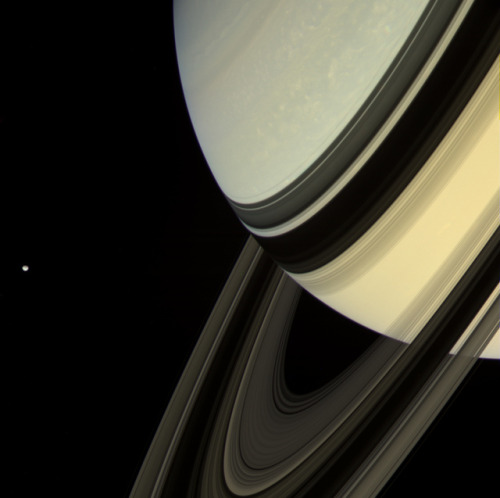






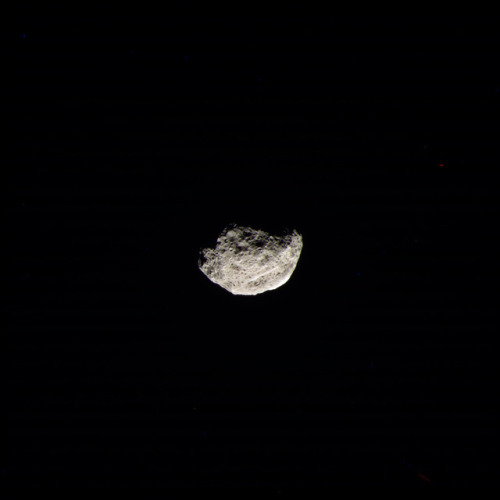

Saturn, rings and moons
NASA/JPL-Caltech/SSI/Kevin M. Gill








Sometimes I wonder how beautiful the Universe is, and we do not even have to go that far. Imagine seeing Neptune and Uranus from their moons…
Images: x, x, x, x, x, x, x (artist’s impression)





Vernier System - Post 2 (Third Planet and its moons)
Here we come across the system’s third planet, a Jupiter-Sized gas giant 1.18 Jupiter Masses orbiting the two suns at an average distance of 2.33 AU. Four massive moon’s all with atmospheres orbit’s the giant. The planet has a very faint ring system in orbit.
High Resolution Pic of the 3rd Planet
Note, the large red nebula in the background NGC 604, one of the largest know nebulas. The Vernier System is located 4,600 light years from the nebula. From here NGC 604 covers over 16 arc degrees of the sky (36 Full-moons), and shines with an average magnitude of -1.91.
The first moon is barren with a surface covered in craters and gray-colored regolith. It is 3.4 lunar masses, with a radius of 2,603.31 km. A thin sulfur dioxide atmosphere clings to the surface. The atmosphere has a very low surface pressure of 0.0001 atmosphere’s. The moon still appears to be volcanically active.
High Resolution Pic of the 1st moon
The second moon has 4 lunar masses with a radius of 2,956.36 kilometers. It’s surface is more geologically diverse with larger quantities of iron oxide. It is more Mars-like than Lunar-like. A sulfur dioxide atmosphere also covers the surface, but is thicker with a surface pressure of 0.017 atmospheres, or roughly just under 3 times thicker than the atmosphere of Mars.
High Resolution Pic of the 2nd moon
The third satellite is by far the largest, and is an Earth-sized moon with a mass of 0.56 Earth’s and a radius 93% that of Earth. It has a thick carbon dioxide-ammonia atmosphere, with a surface pressure 3.48 times that of Earth. Weather is very active on the surface, and the temperature averaging 230 K (-45 °F) supports liquid sulfur dioxide. Sulfur dioxide rain is also common on the surface. The satellite also appears to have a magnetic field.
High Resolution Pic of the 3rd moon
The fourth moon is a second largest with a mass of 0.07 times that of Earth and a radius of 3,274.23 kilometers. It also has a thin sulfur dioxide atmosphere, and sulfur dioxide ice-caps. The atmosphere is 0.017 atmosphere’s thick.
High Resolution Pic of the 4th moon
The System Tag for this system in Spaceengine is RS 1229-169-6-235375-219.










Triangulum Log - Vernier System.
We’ve gone deeper into the Triangulum System and come across this binary system. The system consists of a hot F-Type Star 3.1 times brighter than our sun, orbited by a much less luminous K-Type Star only a fifth the brightness of our sun. The system has 6 planet’s including the most earth-like planet I’ve come across yet.
The Inner-most planet is a warm Ice-Giant with 53 earth masses and atmosphere temperatures of 378 K or 221 °F, orbiting the common center of mass of the two suns at a distance of 0.78 AU. The atmosphere of the planet is extremely turbulent under the intense sun-light. Wind speeds reach up to 1,100 kilometers per hour and cyclonic systems churn across the equator.
The second planet is Earth-like planet roughly 0.20 Earth masses, and radius 0.60 times that of Earth. Liquid water oceans cover a small portion of the surface. The planet is more desert-like than Earth, with water covering less than 15% of the surface. The atmosphere has only 0.15 atmosphere’s of pressure and has an unusual composition. Carbon dioxide comprises 84.4% of the atmosphere mixed with 13.1% Acetylene and 1.3% sulfur dioxide. The acetylene is stable in the atmosphere due to there being no oxygen; however, ultraviolet light natural breaks the compound down, forming Tholins in the atmosphere, giving the atmosphere a thick haze. Surface temperatures average 320 K or 116 °F. The planet has no polar ice-caps and orbits 1.25 AU from the stars. Several asteroid-sized moons orbit the planet along with larger rounded satellite that has a radios of 374 km.
High Resolution Pictures.
Picture 1 - Two Suns and a Giant
Picture 2 - Inner-Most Ice Giant
Picture 3 - White and Orange Suns over stormy skies
Picture 4 - Jewel of the System - Earth-like World
Picture 5 - Desert-world with some seas
Picture 6 - Hazy Atmosphere
Picture 7 - Planet’s Surface
Picture 8 - Different Layers of the atmosphere.
Picture 9 - Planet’s small moon.
Picture 10 - Sun’s setting on the lunar surface.
If the earth had rings, would we see them when it was night? It's a stupid question but still
Yes, just as the moon reflects the light of the Sun, the rings also reflect. But perhaps they would not be like the rings of Saturn, they would be smaller because the Earth has the gravity smaller than the one of Saturn to hold them and also they would not be made of ice, because they would be closer to the Sun. There is a specific point in the System Solar known as “ice line” or “snow line”. This is the point in the Solar System, where ice deposits could have survived for long periods of time. Any closer and the radiation from the Sun sublimates the ice away. Instead, the rings could be made of rock and dust.







Artists Collage of a Gas Giant planet viewed from a Earth-like planet. Scientists estimate there are billions of planets like ours in the Milky Way Galaxy alone.
clothing
What are white dwarfs?
Some curiosities about white dwarfs, a stellar corpse and the future of the sun.

Where a star ends up at the end of its life depends on the mass it was born with. Stars that have a lot of mass may end their lives as black holes or neutron stars.

A white dwarf is what stars like the Sun become after they have exhausted their nuclear fuel. Near the end of its nuclear burning stage, this type of star expels most of its outer material, creating a planetary nebula.

In 5.4 billion years from now, the Sun will enter what is known as the Red Giant phase of its evolution. This will begin once all hydrogen is exhausted in the core and the inert helium ash that has built up there becomes unstable and collapses under its own weight. This will cause the core to heat up and get denser, causing the Sun to grow in size.
It is calculated that the expanding Sun will grow large enough to encompass the orbit’s of Mercury, Venus, and maybe even Earth.

A typical white dwarf is about as massive as the Sun, yet only slightly bigger than the Earth. This makes white dwarfs one of the densest forms of matter, surpassed only by neutron stars and black holes.
The gravity on the surface of a white dwarf is 350,000 times that of gravity on Earth.

White dwarfs reach this incredible density because they are so collapsed that their electrons are smashed together, forming what is called “degenerate matter.” This means that a more massive white dwarf has a smaller radius than its less massive counterpart. Burning stars balance the inward push of gravity with the outward push from fusion, but in a white dwarf, electrons must squeeze tightly together to create that outward-pressing force. As such, having shed much of its mass during the red giant phase, no white dwarf can exceed 1.4 times the mass of the sun.

While many white dwarfs fade away into relative obscurity, eventually radiating away all of their energy and becoming a black dwarf, those that have companions may suffer a different fate.

If the white dwarf is part of a binary system, it may be able to pull material from its companion onto its surface. Increasing the mass can have some interesting results.
One possibility is that adding more mass to the white dwarf could cause it to collapse into a much denser neutron star.

A far more explosive result is the Type 1a supernova. As the white dwarf pulls material from a companion star, the temperature increases, eventually triggering a runaway reaction that detonates in a violent supernova that destroys the white dwarf. This process is known as a single-degenerate model of a Type 1a supernova.

If the companion is another white dwarf instead of an active star, the two stellar corpses merge together to kick off the fireworks. This process is known as a double-degenerate model of a Type 1a supernova.

At other times, the white dwarf may pull just enough material from its companion to briefly ignite in a nova, a far smaller explosion. Because the white dwarf remains intact, it can repeat the process several times when it reaches the critical point, briefly breathing life back into the dying star over and over again.
Image credit: www.aoi.com.au, NASA, Wikimedia Commons, Fsgregs, quora.com, quora.com, NASA’s Goddard Space Flight Center, S. Wiessinger, ESO, ESO, Chandra X-ray Observatory
Source: NASA, NASA, space.com

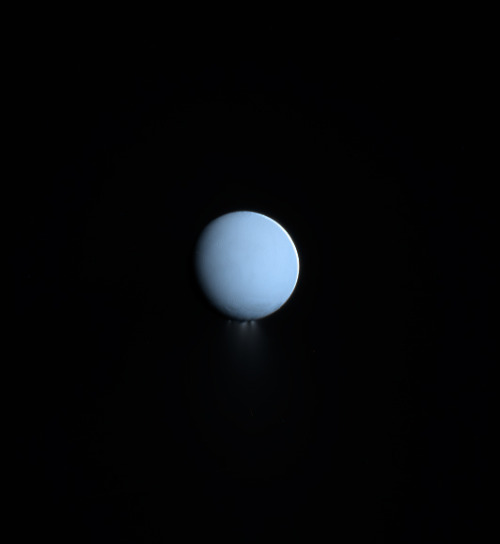



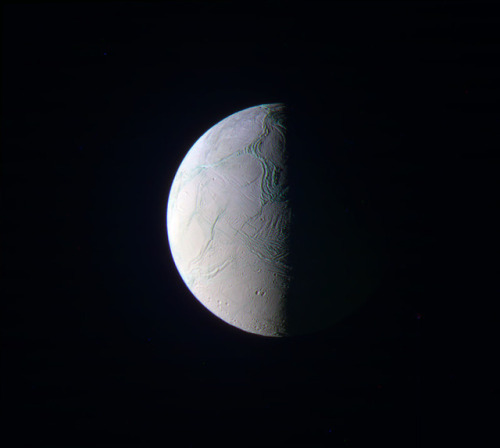

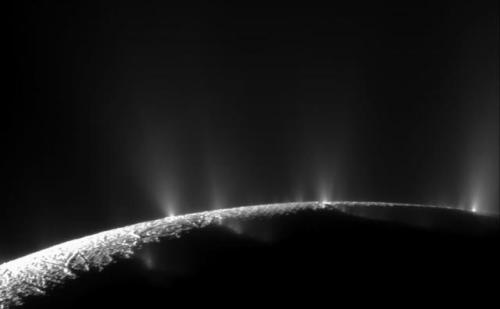

Enceladus
Enceladus is one of the major inner moons of Saturn along with Dione, Tethys, and Mimas. It orbits Saturn at a distance of 148,000 miles (238,000 km), falling between the orbits of Mimas and Tethys. It is tidally locked with Saturn, keeping the same face toward the planet. It completes one orbit every 32.9 hours within the densest part of Saturn’s E Ring, the outermost of its major rings, and is its main source.
Enceladus is, like many moons in the extensive systems of the giant planets, trapped in an orbital resonance. Its resonance with Dione excites its orbital eccentricity, which is damped by tidal forces, tidally heating its interior, and possibly driving the geological activity.
Enceladus is Saturn’s sixth largest moon, only 157 miles (252 km) in mean radius, but it’s one of the most scientifically compelling bodies in our solar system. Hydrothermal vents spew water vapor and ice particles from an underground ocean beneath the icy crust of Enceladus. This plume of material includes organic compounds, volatile gases, carbon dioxide, carbon monoxide, salts and silica.
With its global ocean, unique chemistry and internal heat, Enceladus has become a promising lead in our search for worlds where life could exist.

In 2005, Cassini’s multiple instruments discovered that this icy outpost is gushing water vapor geysers out to a distance of three times the radius of Enceladus. The icy water particles are roughly one ten-thousandth of an inch, or about the width of a human hair. The particles and gas escape the surface at jet speed at approximately 800 miles per hour (400 meters per second). The eruptions appear to be continuous, refreshing the surface and generating an enormous halo of fine ice dust around Enceladus, which supplies material to one of Saturn’s rings, the E-ring.
Several gases, including water vapor, carbon dioxide, methane, perhaps a little ammonia and either carbon monoxide or nitrogen gas make up the gaseous envelope of the plume.
Read more at: solarsystem.nasa.gov
Image credit: NASA/JPL/Cassini & Kevin Gill
What would cause two stars to collide? What does it take for a whole planet (as massive as Jupiter) to change trajectory?
The main mechanism that would make two stars collide is gravity. This depends on several factors, some stars may wander through space and end up being attracted by the gravitational field of another star, from there, one star begins to orbit the other.

But the most common are collisions in clusters of stars, because in a star cluster the stars are very close together, especially in globular clusters.

Collisions of young stars may also occur, as most of the stars are born close to each other in clusters. Many stars are binary, formed together, but in some cases before they evolve they may end up colliding.

In the universe both collisions of active stars can occur, as can collisions of white dwarfs, neutron stars and black holes.
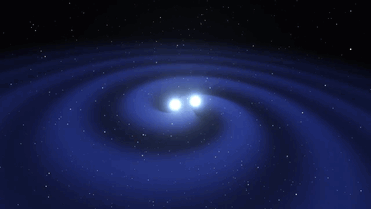
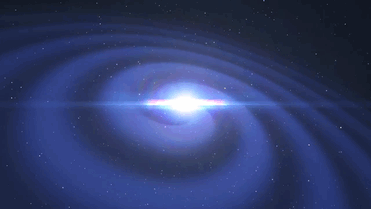
The orbits of the planets are determined by the gravitational pull of the Sun, so it would need some very extreme force to cause the orbit of a planet to change its trajectory, perhaps if some planet or star enters our solar system, or when the Sun goes through changes and become a white dwarf in about 5 billion years.


![Purple Matter [500 X 750] By Skratt](https://64.media.tumblr.com/51a0374610bfbc488c77e06e4caa581f/tumblr_pfo1ajoUYD1wf4hhqo1_500.jpg)
![Star Cluster Melotte 15 In The Heart Nebula [IC 1805]](https://64.media.tumblr.com/8b8ffde97e975e9cf7889e2625a4928f/tumblr_pf830p2BAC1vhj0upo1_500.jpg)



















